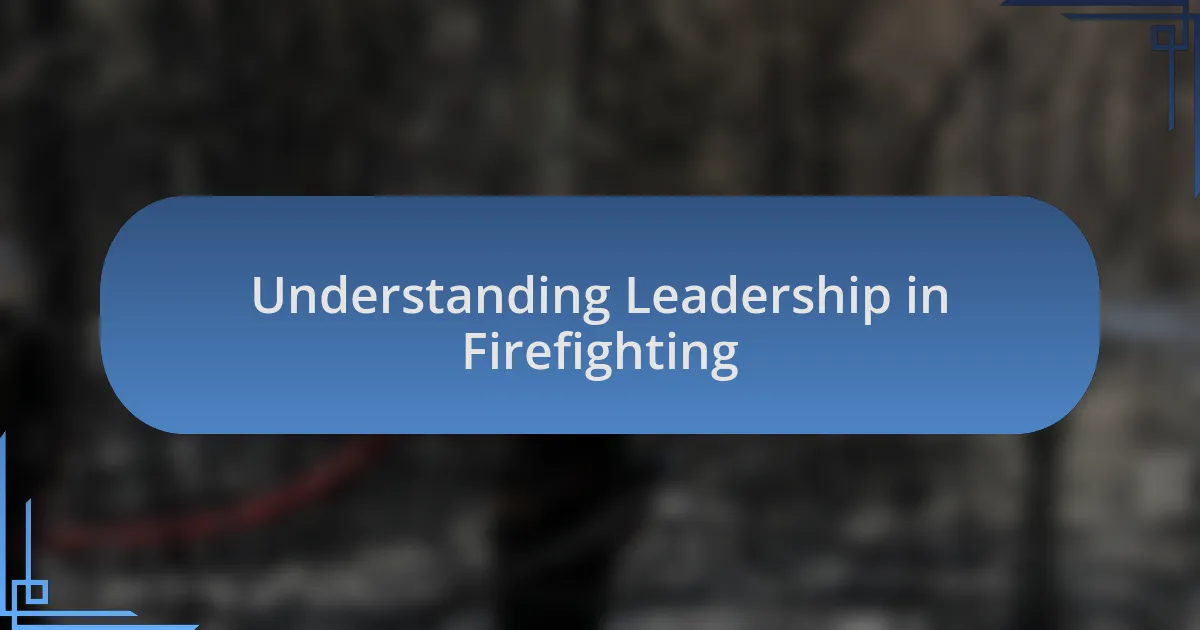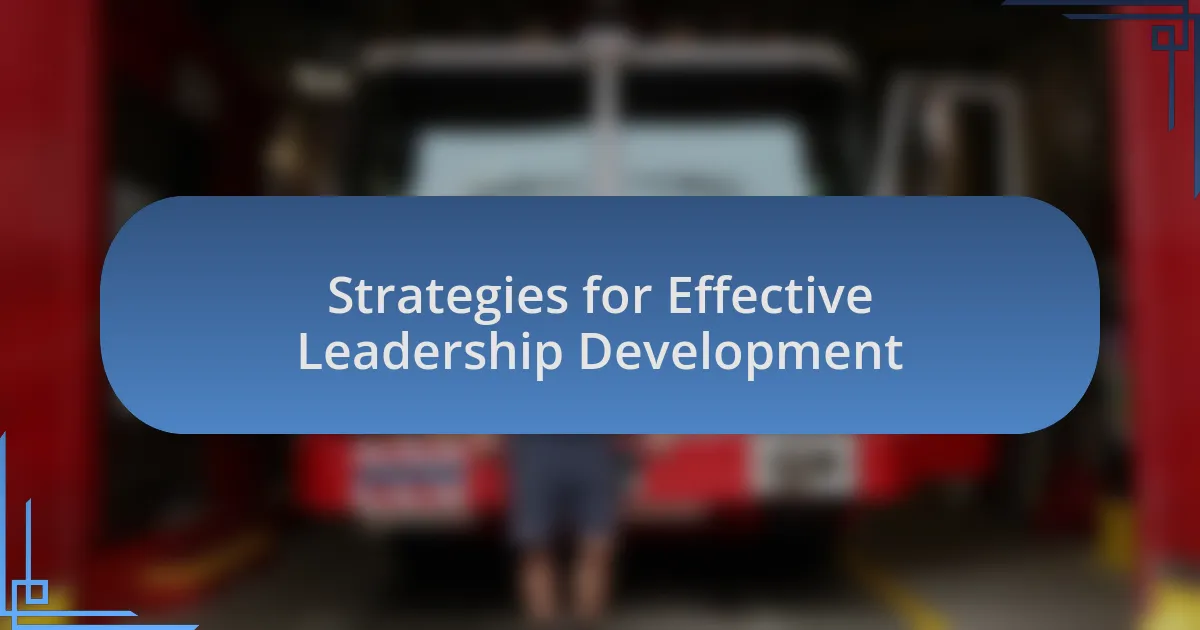Key takeaways:
- Effective leadership in firefighting hinges on trust, communication, and adaptability, particularly during high-pressure situations.
- Emotional intelligence and vulnerability are crucial for fostering teamwork and supporting team members’ well-being.
- Implementing leadership theories like transformational and servant leadership can significantly enhance team dynamics and performance.
- Continuous learning, mentorship, and open communication are essential strategies for developing effective leadership within teams.

Understanding Leadership in Firefighting
Leadership in firefighting is about more than just giving orders; it’s about inspiring trust and fostering teamwork. I remember one particularly tense call when a rookie firefighter, visibly shaken, turned to me for guidance. In that moment, leading wasn’t about my experience; it was about reassuring him that we were in it together. How do we build such trust? It starts with vulnerability and openness.
Effective leaders in the fire service must also adapt to rapidly changing situations. I once encountered a fire where conditions shifted dramatically, and my initial plans became obsolete. I realized then that a successful leader must be both decisive and flexible. Have you considered how your decision-making might differ under pressure? It’s these experiences that shape our ability to lead during moments of crisis.
The emotional strength needed in firefighting leadership cannot be overstated. There are moments of shock and grief, especially when faced with a loss in our community. I’ve felt that weight personally and learned that true leadership involves acknowledging these feelings, not brushing them aside. How can we expect our team to follow if we don’t show our humanity? Embracing this vulnerability not only strengthens our bonds but also enhances our ability to combat the wildest challenges we face.

Importance of Leadership in Emergencies
In emergencies, strong leadership can be the difference between chaos and effectiveness. I recall a time when we were battling a multi-alarm blaze in a commercial building. As the smoke thickened, I took a moment to gather my team, reminding them of our training and emphasizing our collective skills. It struck me how, in that moment, reassurance turned fear into focus. Why is it that a few encouraging words can shift everyone’s mindset? Leadership during crises is about cultivating resilience and fostering a sense of purpose.
The ability to communicate clearly and assertively under stress cannot be overstated. During one intense incident, the radio chatter escalated along with the flames. I made a conscious effort to keep the lines clear and concise, guiding my team through each decision. It was then that I understood how vital effective communication is in steering everyone towards our common goal. Have you ever considered how miscommunication could jeopardize not just a mission, but lives? This is why honing our communication skills is essential for any leader facing emergencies.
Trust plays a crucial role in emergency situations. I remember a fireground scenario where decisions had to be made in seconds. The team looked to me, not just for directives, but for assurance that they were capable. It dawned on me that trust is built long before the sirens sound. So, how do we earn it? By being consistent, supportive, and transparent, we create an environment where team members feel empowered to take initiative, ensuring our effectiveness even in the direst situations.

Key Leadership Traits for Firefighters
Effective leadership in firefighting hinges on a commitment to integrity. I recall an incident where we faced a tough decision on whether to enter a burning structure despite the obvious risks. As a leader, I felt it was crucial to be honest about the potential dangers, which, in turn, fostered trust within my team. When firefighters know that their leader prioritizes honesty, they are more likely to share their concerns and insights, ultimately making our collective decision-making stronger. How often do you think integrity shapes the dynamics within a team during critical moments?
Another essential trait is adaptability. In one of my earliest firefighting experiences, a last-minute change in the wind direction jeopardized our safety strategies. Observing my crew’s initial panic, I quickly adjusted our plan and guided them through the new circumstances. It taught me that an effective leader must remain calm and flexible, ready to pivot as situations evolve. Have you ever had to adjust plans on the fly? Those moments can define our effectiveness as leaders in high-stakes environments.
Finally, emotional intelligence ranks among the top leadership traits for firefighters. I once encountered a crew member who became visibly distressed during a particularly grueling rescue operation. Instead of pushing forward blindly, I took the time to check in with him, showing that we are a team that cares deeply for one another. It’s easy to overlook emotions when urgency drives us, but recognizing and addressing them can strengthen bonds and enhance overall team performance. How do you ensure that emotional well-being is prioritized amidst the chaos?

Lessons from Leadership Books
The importance of communication stood out profoundly while reading leadership books. I remember a particularly challenging training session where confusion reigned due to unclear instructions. Seeing my team struggle, I realized that fostering open lines of communication not only clears confusion but also empowers individuals to voice their thoughts. Have you ever experienced a moment where a lack of clarity impacted your performance?
Another lesson that resonates deeply with me is the power of delegation. There was a time when I took on too many responsibilities during a large-scale drill. Instead of empowering my crew to step up, I ended up overwhelmed and ineffective. This taught me that trusting team members with responsibilities not only builds their confidence but also enhances our overall efficiency. How often do we miss opportunities to lift others by shouldering too much ourselves?
Lastly, the value of continuous learning struck me as I explored various leadership philosophies. Engaging with new concepts has encouraged me to seek feedback from my peers and mentors. During this process, I grew more appreciative of the diverse perspectives in our field, recognizing that consistent self-improvement ultimately leads to stronger leadership. What strategies have you found helpful in your own journey of leadership growth?

Applying Leadership Theories to Training
Applying leadership theories to training can radically transform how teams operate. For instance, I once implemented transformational leadership techniques during a workshop, focusing on inspiring my colleagues to take ownership of their learning experiences. Witnessing how enthusiasm can ripple through a team made me realize that when individuals feel valued and motivated, they often exceed expectations. Have you ever considered how your leadership style energizes those around you?
In another training scenario, I turned to a situational leadership model, adapting my approach based on the needs of the group. This meant switching from a directive style to one that encouraged collaboration. By recognizing when a team member was hesitant to contribute, I created a supportive space for them to express their ideas. This adaptability not only fostered a sense of inclusiveness but also reinforced the idea that every voice matters. Have you thought about how adjusting your leadership approach could impact your team’s dynamics?
Moreover, I’ve found that incorporating servant leadership principles has profoundly influenced our training environment. During a particularly demanding exercise, I shifted from leading with authority to prioritizing my team’s needs, ensuring each member had the support and resources they required. The transformation in morale was palpable, and it served as a powerful reminder that leadership is often about serving others first. Isn’t it amazing how a focus on support can inspire incredible commitment and trust among team members?

Personal Experiences with Leadership Skills
There was a time when I faced a challenging situation during a live training drill. One of my team members was struggling with the high-pressure environment, and instead of pushing them to keep up, I took a moment to step back and acknowledge their discomfort. By actively listening and offering reassurance, I saw them transform from hesitant to confident, reminding me that great leadership often involves understanding and empathy. Have you ever paused to truly connect with your team in moments of difficulty?
In another instance, I had the opportunity to lead a debriefing after a particularly intense exercise. I noticed that everyone wanted to share their thoughts, but I had to be careful about dominating the conversation. Instead of speaking over others, I invited quiet voices to contribute, which created a richer dialogue. That experience taught me that vulnerability and humility can forge stronger bonds within a team. Can you think of times when amplifying others’ insights led to unexpected breakthroughs?
Reflecting on these experiences, I’ve come to appreciate the profound effect that patience and encouragement can wield in leadership. I recall a moment during a major project where my supportive approach allowed an unsure firefighter to shine. Their success not only boosted their confidence but also inspired the entire team. This illustrates how cultivating a nurturing environment can elevate everyone’s performance—how often do we truly celebrate our team’s achievements?

Strategies for Effective Leadership Development
Developing effective leadership strategies often begins with establishing a culture of open communication. In my experience, I’ve found that regular check-ins and feedback sessions can create a safe space for team members to voice their concerns. How often do we forget the importance of dialogue in building trust? By ensuring everyone feels heard, leaders can foster an environment that encourages growth and collaboration.
One strategy I found particularly impactful is mentorship. I once had a mentor who guided me through complex situations, offering insights that I hadn’t considered. This kind of relationship not only enhances individual skills but also strengthens the team as a whole. Have you thought about the potential benefits of being a mentor or having one? The reciprocal nature of mentorship can create a cycle of leadership development that benefits everyone involved.
Another essential strategy is to lead by example. I recall a time when I faced my own moments of doubt during a challenging incident. Instead of masking my vulnerability, I shared my thoughts with the team, showing them that it’s okay to struggle sometimes. That moment of honesty not only humanized me as a leader but also encouraged my team to support each other in difficult times. Isn’t it powerful to think that our willingness to be authentic can inspire others to do the same?